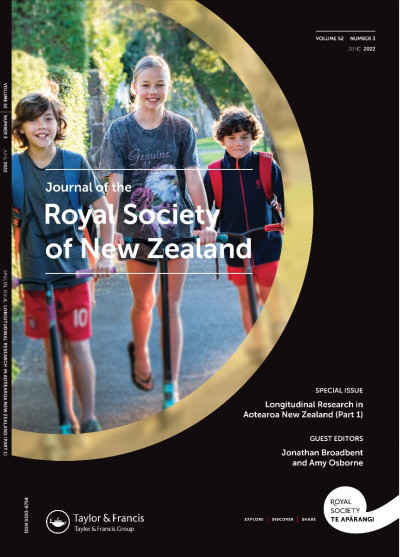News
Published 7 July 2022Special issue on longitudinal research in Aotearoa New Zealand released
Part one of a special issue on longitudinal research in Aotearoa New Zealand has been published in the Journal of the Royal Society of New Zealand and includes six papers.

Cover image provided by Growing Up in New Zealand longitudinal study, the largest contemporary longitudinal study of child development in Aotearoa New Zealand. Photo credit: Shona Dey, 2020.
As the guest editors Jonathan Broadbent (Otago) and Amy Osborne (Canterbury) note in their editorial, Aotearoa New Zealand has a thriving longitudinal research community, as evidenced by the number of high-quality and seminal papers published in this Special Issue.
Some of the questions that longitudinal studies are intended to help address include:
- How do people live?
- How do we change as we grow?
- What happens as we get older?
- If an event or experience occurs during childhood, will it have an affect in later life, and how?
Three of these are reports from investigators with the Growing up in New Zealand Study, our largest longitudinal study of child development. Other papers are based on findings from the Dunedin Multidisciplinary Health and Development Study, the Christchurch Longitudinal Study, as well as the Moe Kura study, reporting on sleep at the very beginning of life.
Firstly, Morton and colleagues review findings from the considerable body of work contributed by the Growing Up in New Zealand longitudinal study that study on the issue of inequality. They discuss the disproportionate impacts on wellbeing for Māori and Pacific children, and how socioeconomic hardship can lead to intergenerational continuity in inequality.
A second report from Growing Up in New Zealand, by Atatoa Carr et al., tackles the challenge of understanding the self-identification of ethnicity in Aotearoa New Zealand. Their findings have important implications for understanding how people identify themselves, and how this can change or remain stable over time. This has implications both for how we understand society and for how we should conduct longitudinal research.
Next, Paine and colleagues discuss the importance of protecting participants in longitudinal research. They discuss the potential that following kaupapa Māori approaches hold for longitudinal research in Aotearoa New Zealand, and give the example of how Kaitiaki guardianship principles have been applied in the Growing Up in New Zealand cohort in order to protect participants and remain true to Te Tiriti o Waitangi.
Moving to some older cohort studies, Ruiz et al. discuss some of the issues in using early findings from the Dunedin Multidisciplinary Health and Development Study and the Christchurch Longitudinal Study to help understand the issues of today, using the example of oral health. Oral health is an under-investigated issue in a majority of longitudinal studies. Oral health among Aotearoa New Zealand children remains problematic, and this study shows how oral health at age 5 in the Dunedin and Christchurch cohorts roughly mirror the oral health status of 5 year old children today.
Signal and colleagues report on sleep at the very beginning of life, using findings from the Moe Kura study, a study grounded in Kaupapa Māori methodology. They report rich intergenerational data on sleep among mothers during pregnancy, around the time of birth, and in the years following, as well as sleep among their children. They report important findings on the value of sleep for child health, and on the inequity in good sleep.
Finally, Milne discusses the Integrated Data Infrastructure, or IDI, a system of compiling deidentified administrative data for the whole population of Aotearoa New Zealand, and gives examples of how this has been applied to enable longitudinal research. The paper discusses the challenges with the IDI, including its limitations and important ethical governance issues with the use of the data.
All the papers are freely accessible at the moment. https://www.tandfonline.com/toc/tnzr20/52/3
In their editorial, the guest editors also note that to continue to thrive, the longitudinal research community must both replenish and maintain an active, well-resourced and well-supported research workforce, as well as replenish and maintain the cohorts that are so integral to the longitudinal studies. They call for national infrastructure to support these studies and to see incentives to encourage collaboration between studies.
These papers are approximately half the planned articles on longitudinal research in Aotearoa New Zealand. The second part of this special issue will include further editorial commentary from prominent researchers in longitudinal research on the findings and future of longitudinal research in Aotearoa New Zealand.
